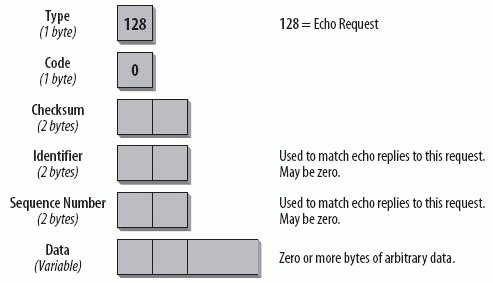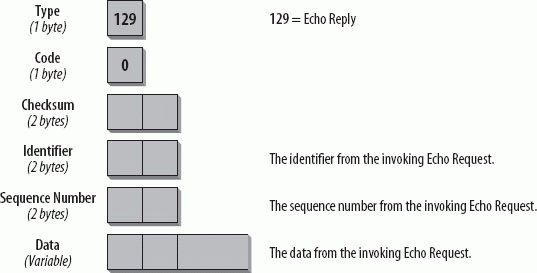Section 4.3. ICMP Informational Messages
4.3. ICMP Informational MessagesIn RFC 4443, two types of informational messages are defined: the Echo Request and the Echo Reply messages. Other ICMP informational messages are used for Path MTU Discovery and Neighbor Discovery. These messages are discussed at the end of this chapter and defined in RFC 2461, "Neighbor Discovery for IP Version 6," and RFC 1981, "Path MTU Discovery for IP Version 6." The Echo Request and Echo Reply messages are used for one of the most common TCP/IP utilities: Packet INternet Groper (ping). Ping is used to determine whether a specified host is available on the network and ready to communicate. The source host issues an Echo Request message to the specified destination. The destination host, if available, responds with an Echo Reply message. Figures 4-8 and 4-9 (later in the chapter) show what a ping looks like in the trace file. 4.3.1. Echo Request MessageThe format of the Echo Request message is shown in Figure 4-6. Figure 4-6. Format of the Echo Request message The Type Field is set to 128, the value for the Echo Request. The Code Field is not used for this message and is therefore set to 0. The Identifier and Sequence Number fields are used to match requests with replies. The reply must always contain the same numbers as the request. Whether an identifier and a sequence number are used and what kind of arbitrary data is included in the Echo Request depends on the TCP/IP stack you are using. When you analyze trace files with Echo Request and Echo Reply messages and you are familiar with some stacks, you can determine the TCP/IP stack of the sender by looking at the arbitrary data. You can see an example of this in Figures 4-8 and 4-9, later in this chapter. 4.3.2. Echo ReplyThe format of the Echo Reply message is very similar to that of the Echo Request, as shown in Figure 4-7. Figure 4-7. Format of the Echo Reply message The Type field contains the value 129 for Echo Reply. The Code field is unused and set to 0. The Identifier and Sequence Number fields must match the fields in the request. The data of the Echo Request message must be copied into the reply entirely and unmodified. If an upper-layer process initiated the Echo Request, the reply must be passed to that process. If the Echo Request message was sent to a unicast address, the Source address of the Echo Reply message must be the same as the Destination address of the Echo Request message. If the Echo Request was sent to an IPv6 multicast address, the Source address of the Echo Reply must be a unicast address of the interface on which the multicast Echo Request was received. ICMPv6 Echo Request and Reply messages can be authenticated, using an IPv6 authentication header. This means that a node can be configured to ignore nonauthenticated ICMPv6 pings and provide protection against different ICMPv6 attacks. |